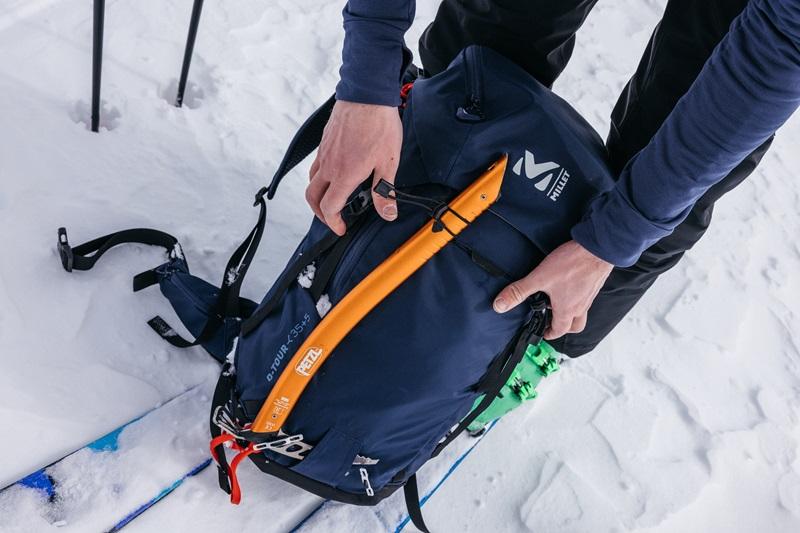The ice axe is a key element of your mountaineering equipment. It is an essential tool in the mountains. Choosing the right type of ice axe for your needs is crucial to ensure your safety. That’s why Glisshop offers this buying guide to help you find the model best suited to your activity. From glacier hiking to technical mountaineering on steep terrain, as well as ski mountaineering races or ice climbing, we cover everything. After reading this guide, you will know which type of ice axe to choose, the ideal shaft shape, the right size, the standards, and more.

Anatomy of an Ice Axe
An ice axe consists of a head and a shaft, typically ending with a spike. Each part serves a purpose:
- The head is made up of a pick at the front and an adze or a hammer at the back. The pick is used for anchoring. The adze is used to cut steps in hard snow or ice, while the hammer is used to drive in pitons.
- The shaft is the part held in the hand and can be gripped at various heights.
- The spike is located at the end of the shaft, aiding penetration into snow and grip on ice when the ice axe is used as a cane.
Some models may include additional features:
- A leash or wrist strap, allowing the ice axe to be secured to your wrist or harness. However, a leash can make it more cumbersome to switch the ice axe between hands.
- Weights are removable components attached to the head. These small parts enhance inertia for optimal striking power.
- A finger rest on the shaft can improve grip by supporting your fingers.

Ice Axe Types (B/T or 1/2)
Ice axes are classified into two categories based on their level of strength:
- Type B or 1 (basic): These ice axes have a thinner pick, making them lighter and less durable. They are suitable for glacier hiking.
- Type T or 2 (technical): With a thicker pick, these ice axes are more durable. They are designed for more demanding activities. They offer superior traction capability and greater resistance to bending.
Choosing Based on Your Activity
In the mountains, choosing the right equipment depends greatly on your activity. This is true for crampons, boots, clothing, as well as ice axes. Ice climbing requires a different type of ice axe than glacier hiking, and technical mountaineering demands a different ice axe than ski touring, etc. Find out how to pick the right model.
Ice Axe for Glacier Hiking
For glacier hiking, where the ice axe is used as a walking stick, we recommend an ice axe with a straight or nearly straight shaft. The teeth on the pick can be less aggressive, as the ice axe mainly serves as a support point while walking.
Ice Axe for Technical Mountaineering
For technical mountaineering, you need a versatile ice axe. During an alpine climb, you may encounter a wide variety of terrains. Your ice axe will be used for various techniques and manoeuvres such as performing a self arrest, using it as a cane, cutting steps, etc. The shaft should be straight or moderately curved, and the pick should have teeth that easily penetrate hard snow and ice.
Ice Axe for Ice Climbing
For mountaineering on very steep slopes and ice climbing, you will need technical ice axes. These demanding disciplines require the use of two ice axes. The shafts are short and highly curved, often with finger rests for better grip. The picks are interchangeable, allowing you to adapt your equipment to the quality of the ice. They are also very sharp and robust.
Ice Axe for Ski Touring
In ski touring and ski mountaineering, the ice axe is only used when necessary and is not central to your activity. This backup ice axe will spend most of the outing attached to your backpack. The main criterion is thus lightness. We recommend a model with a short, straight shaft. As for materials, aluminium helps reduce the weight of your gear.
For more details, we have prepared a buying guide for ski touring ice axes.
What Size for a Straight Ice Axe or a Technical Ice Axe?
The size of the ice axe primarily depends on its intended use:
- For glacier hiking: The shaft should be long enough to use the ice axe as a walking stick. As a guideline, when you hold the head of the ice axe with your arm extended along your leg, the spike should reach your ankle.
- For technical mountaineering: The shaft is shorter, allowing to perform various techniques. We recommend a length between 50 and 70 cm.
- For ice climbing: The shaft is very short, less than 50 cm. The ice axe is highly manoeuvrable and allows for optimal striking in ice and hard snow.
- For ski touring: The shaft is short to minimise size and weight. We recommend an ice axe between 50 and 60 cm, ensuring it doesn’t get in the way when attached to your backpack.
What Is the Best Ice Axe?
There is no such thing as the best ice axe. It all depends on your usage. As you now understand, the type and size of the ice axe depend on your activity and needs. Depending on the terrain you venture onto, one model may be more suitable than another. The shape of the shaft, its length, the tooth profile, and the style of the ice axe head all depend on what you plan to do with it.

